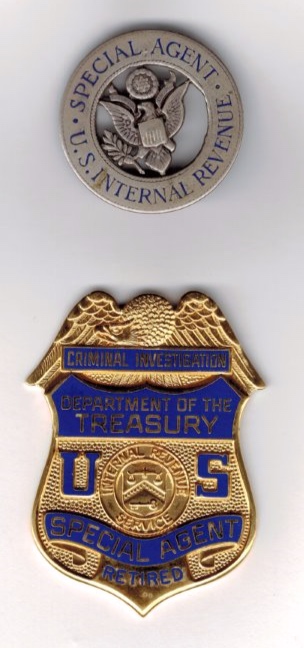(Courtesy of the Irey family)
Elmer Lincoln Irey
Elmer Lincoln Irey (1888 - 1948) was one of 7 children. After the family moved to D.C., the father abandoned them. As Elmer matured, he intuitively knew what was unquestionable for his mother and siblings. A quick study of any task, virtuous with patience and diligence, and having an investigative and forensic intellect, he had a meteoric rise in the Untied States Postal Service; and soon thereafter, his superb management skills were validated in 1919. That year, he became the first Chief of the Treasury Department, Bureau of Internal Revenue, Enforcement Branch, Special Intelligence Unit (“IU”) (since 1978 IRS- Criminal Investigation ("CI")). Irey was beyond successful in bringing down the biggest tax dodgers and corrupt politicians of the first half of the 20th century.
A humble man, unconcerned with recognition, Irey’s investigations led to the convictions and incarcerations of America’s most notorious gangsters, the 'Criminal Elite', if you will. The litany of cases is legendary. The issues adjudged more than just bootlegging. Murder, racketeering, prostitution, gambling and corruption were the daily events. In the early 1920s, Irey dealt with corruption amongst the agents in the Bureau of Prohibition. Graft infiltrated at all levels, including some directors and persons in the Harding administration. Before the Justice Department took the reins of the Prohibition Agency in 1928, Irey had to fire 706 agents for larceny and prosecuted 257 for the same. Amongst all federal bureaus, the Intelligence Unit was a paragon of virtue throughout Irey's commission. His unique insight for choosing the right men; and his superb management skills, were paramount to anyone else in all the federal agencies.
With the 1927 Supreme Court Sullivan decision that ‘ill-gotten gains’ could be subjected to income tax, a new wave of investigation ensued. This segued way into, Herbert Hoover (elected in 1928) charging Treasury, more specifically Irey, with the task to get Capone. By mid 1928 (family documents confirm such) and into early 1929, Irey’s triumvirate (Wilson, Madden and Malone) was being better defined for the herculean assignment. Wilson would be the ‘outside’ agent charged with analyzing the books. Malone would be 'deep cover' who infiltrated and then lived at 'Camp Capone', the Lexington Hotel. Madden was Chief of the Chicago Division. They labored for nearly three years. At that time, the Capone case was the 2nd most in federal man-power hours expended (Lincoln was first). Conviction finally came in October 1931.
Five months after the Capone conviction, Irey, working in N.Y.C. with Tom Dewey and Malone on the Waxey Gordon case, was called to help solve what became ‘The Crime of the Century’, the Lindbergh baby kidnapping. Lindbergh was aware of the great work the Intelligence Unit had done with Capone. The aviator called his good friend, Ogden Mills, Secretary of the Treasury, for help. At that time there were no federal laws regarding kidnapping. The IU ‘set the trap’ that led to Hauptmann’s capture, conviction and execution. The bills were recorded, sealed in a laminated box and tied with a special string. Samples of the wood, string and the list of numbers on the bills were saved for the evidentiary trail that eventually led them to Bruno Hauptmann. Amongst these documents are notes that reveal how distraught Lindbergh was and leave no doubt there were other kidnappers. Lindbergh and Col. Breckenridge, his advisor, wrote Irey, Wilson and Madden heart-felt letters of thanks for solving this tragedy.
By the late ‘30s, Secretary of Treasury, Henry Morgenthau, Jr., charged Irey as overseer of several other Treasury law enforcement bureaus: Secret Service, Customs, Narcotics, Alcohol Tax Unit and the Coast Guard. In 1939, over 64% of prisoners incarcerated was due to his diligence and vigilance as Chief of these agencies, especially the IU. Also, in the late 1930s, Irey was the first to send Malone to explore offshore money laundering.
The prominence the IU created over the years (1919 – 1940) by taking down the major kingpin gangsters (resulting in ‘mega-windfalls’ of taxes, interest and fines); in addition to being instrumental in solving the Lindbergh kidnapping; set the stage, an aura of courage and character, that President Roosevelt acknowledged in his 3/9/1942 letter to Irey (see Our Mission Section). This aura allowed FDR to raise the tax strata and rates in March 1942 (three months after Pearl Harbor) to fund the War Chest and stop the AXIS Forces from moving across Europe. This Taxes to Beat the Axis Program was also memorialized in an Oscar nominated Disney Film. Many consider Irey as one of the five most important people in the US during World War II.
In 1940, Congressman Cochran read into the congressional record that the IU brought in $30.00 for every $1.00 in overhead. In today’s dollars, the IU’s ‘take’ of that era was many billions. These men are known as the 'Fathers of Forensic Accounting'. Their moniker, 'Follow the Money' lives on in their legacy as the modus operandi embraced by the best financial investigators the world has ever known, the IRS- Criminal Investigation Division. Not only does the Criminal Investigation brings in exceedingly more than its budget; but also it is the 'go to' law enforcement agency that the other federal bureaus rely on in our ever changing world of racketeering, money laundering and battles with terrorism.
Contrary to his Bureau of Investigation's (F.B.I.) counterpart, whose self-accolades moved across the American landscape in search of appreciation, Irey’s accomplishments were not as widely known. He was the consummate Chief, extolling praise on the team. Irey is widely considered the most accomplished and greatest investigative mind of the 20th Century (Life Magazine, Washington Evening Star, Alan Hynd, Hank Messick, Robert Folsom etc.). He retired from government in 1946 and passed in 1948.

